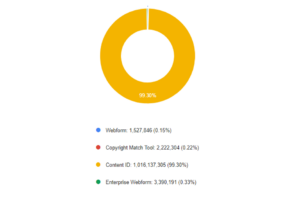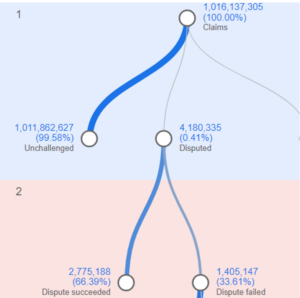Content creation on YouTube reportedly reached a new peak during the second half of 2023, meaning that the platform experienced a surge in infringing uploads on the one hand, and copyright actions by its users on the other. The platform’s automatic detection technologies have once more been put to the test, while compliance with the obligations under Article 17 of the CDSM 2019/790 undoubtedly poses a challenge. Accordingly, the provision places online content-sharing service providers (OCSSPs) at risk of liability for making copyright protected content available within the EU, unless they can show that they fulfil a number of duties under sub-section (4). Of importance is YouTube’s implementation of ex-ante measures to mitigate unjustified copyright actions, including an expeditious ‘appeal’ system for users whose content has been blocked or demonetised, as well as manual intervention at different stages of its filtering processes, as enshrined in sub-section (9) of the same Article.
Earlier commentaries (here and here) on previous versions of YouTube’s Report explored the potential over-blocking of uploaded content, which could adversely affect the rights of millions of users, as well as speculation on potential future safeguards within the platform’s copyright enforcement mechanisms. In its most recent Transparency Report, covering activities carried out between July to December 2023, it appears that YouTube has taken positive steps to address both, at least to some extent.
Filtering
It is only to be expected that YouTube would have implemented an automated filtering system in order to deal with the ever-increasing copyright claims and content removal requests by its users – in fact, over a billion copyright actions in the examined 2023 period, compared with 729.3 million in the first half of 2021. The platform offers rightsholders access to automatic detection technology for infringing, or potentially infringing, content through a number of tools with varying levels of automation: the Webform, designed for infrequent use by creators who hold few copyrights and rarely find their content on YouTube; the Copyright Match Tool, available to over 3 million YouTube channels who experience reposts more frequently; and ContentID, available to a few thousand collecting societies, movie studios and music labels, for instances of heavily reposted content, such as the latest viral video.
Although over 60% of claimants for content removal were Webform users (169,424 claimants), the Report points out that it was the Content ID minority (4,511 claimants) who were responsible for ‘over 99% of all copyright actions on YouTube’. Yet, the attempted abuse rate (or else, the rate of unjustified user requests to YouTube for either video takedowns and/ or demonetisation of content via filtering [that adversely impacts copyright owners’ interests]) was 10 times higher in Webform claims compared to the other two copyright removal tools with limited access, where the levels of abuse reportedly remained low. These data hint that those who try to ‘manipulate’ the system are mainly YouTube users that do not qualify for accessing the platform’s scaled tools. According to the Report, such users commonly have ‘a lack of understanding about copyright’ and while the abuse rate on their part was much higher compared to users of access-restricted tools, the actual volume of abusive claims arising from Webform users is small, given that their overall copyright actions represented less than 1%.

In the second half of 2023, YouTube uploaders challenged less than 10% of the platform’s copyright actions in all tools combined and less than 0.5% in Content ID alone. Yet one cannot overlook the 2.7 million abusive copyright actions that have taken place within the latter, despite approximately 65% of Content ID claims being resolved in favour of the uploader. Importantly, claims may be resolved as quickly as within a 30-day timeframe, an expeditious process that gives regard to both copyright works’ time-sensitive nature, particularly when it comes to the type of content managed by Content ID enterprise partners, as well as users’ right to access and/or to make their content available. In a nutshell, although the overall abuse percentage remains low and ‘over-blocking’ concerns are not substantiated based on the Report, the unjustified removals or demonetisations even in the most advanced form of YouTube’s automatic detection technologies cannot guarantee complete protection of users’ rights.

What contributes to a more balanced picture, however, is the fact that 90% of the remaining 99.58% unchallenged Content ID claims were monetized, rather than blocked altogether, by choice of the rightsholders. Hence, with respect to the largest volume of copyright actions on the platform within Content ID, the Report showcases that a great deal of content remained available for public view. On top of that, YouTube claims that for instances where the automated filtering system is uncertain as to whether a claim has been made in error manual review by the ContentID administrators is required and, thereby, overrides automation. This is an example of an ex-ante measure that YouTube has embedded within its systems, in line with its obligations under Article 17 of the CDSM 2019/790, so as to best safeguard freedom of speech and the rights of other rightsholders.
Furthermore, the platform claims that ‘the limited availability of Content ID [to enterprise partners] also helps to limit abuse of that tool’, as an incorrectly approved takedown request could impact not just a few, but thousands of uploads that match the reference content due to its automated nature. This could lead to large-scale unjustified blocking, posing an even more serious threat to users’ rights compared to the current reality. Equally, only users with a prior successful copyright removal request through the Webform or with a subscription to the YouTube Partner Program are qualified to access the Copyright Match Tool, as an added layer for preventing misuse of the system in place. Effectively, restricting access to these two enforcement tools is claimed to be a contributing factor in maintaining an overall low rate of abusive takedowns on the platform. Yet, in an attempt to align with its CDSM obligations, YouTube has recently enabled filtering as an option that Webform users can opt for manually – rather than opening up the gates to its other tools and the accompanying automated filtering feature to all users.
In conclusion, the Report showcases positive steps that YouTube has taken in order to comply with its OCSSP obligations under Directive 2019/790, as well as to strike a better balance between the rights of rightsholders and users. An increase in content creation is a positive indicator and, in fact, YouTube has paid more than $70 billion to rightsholders over the past 3 years. Yet, copyright infringing uploads are also increasing at a rate that only automated filtering technology can cope with. And while copyright holders’ rights are ensured with state-of-the-art filtering tools, the platform has shown that users’ rights are being taken seriously, by slowly and steadily developing ex-ante measures and a speedy complaint system to rectify any instances of unjustified blocking.
________________________
To make sure you do not miss out on regular updates from the Kluwer Copyright Blog, please subscribe here.


